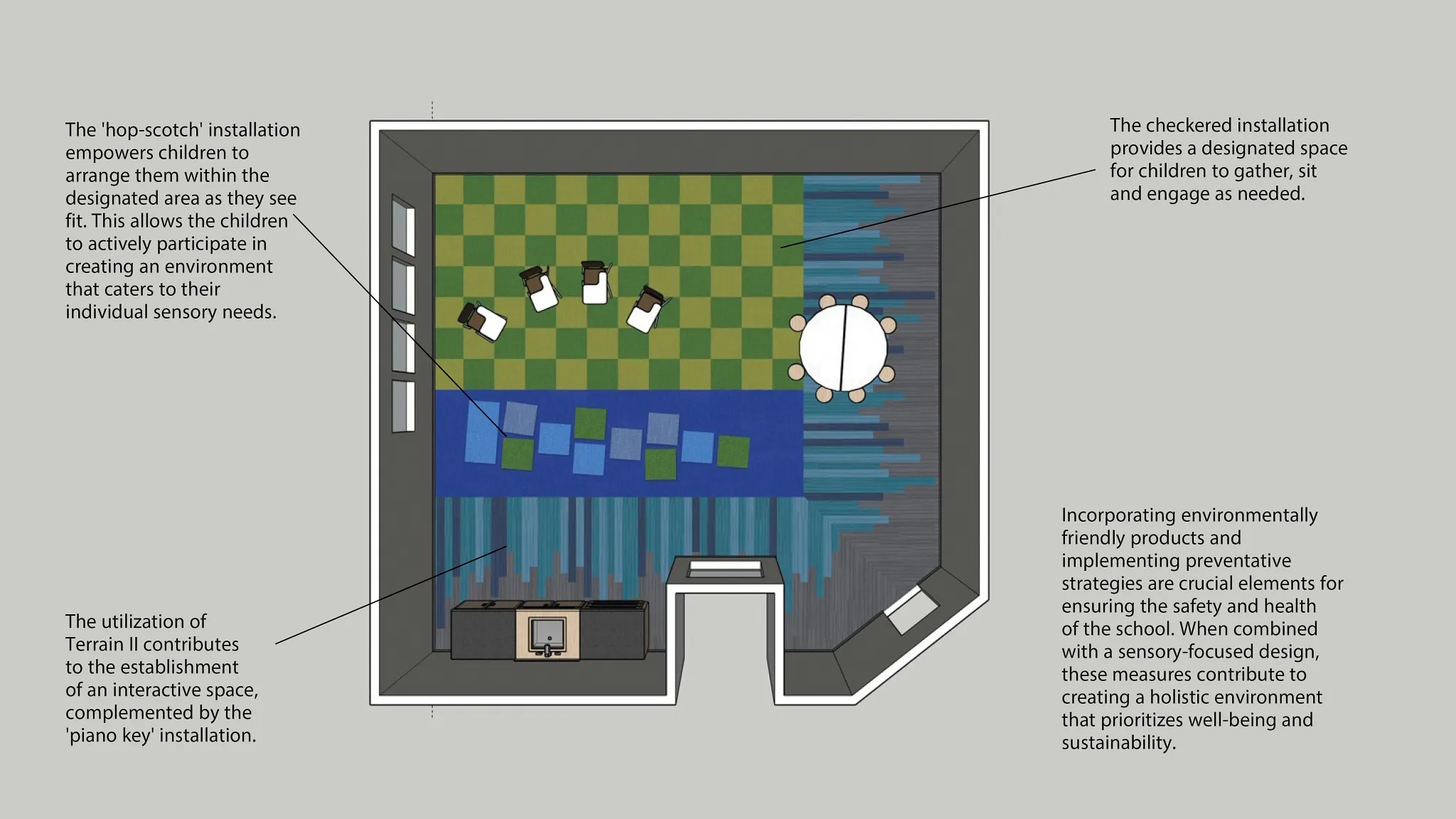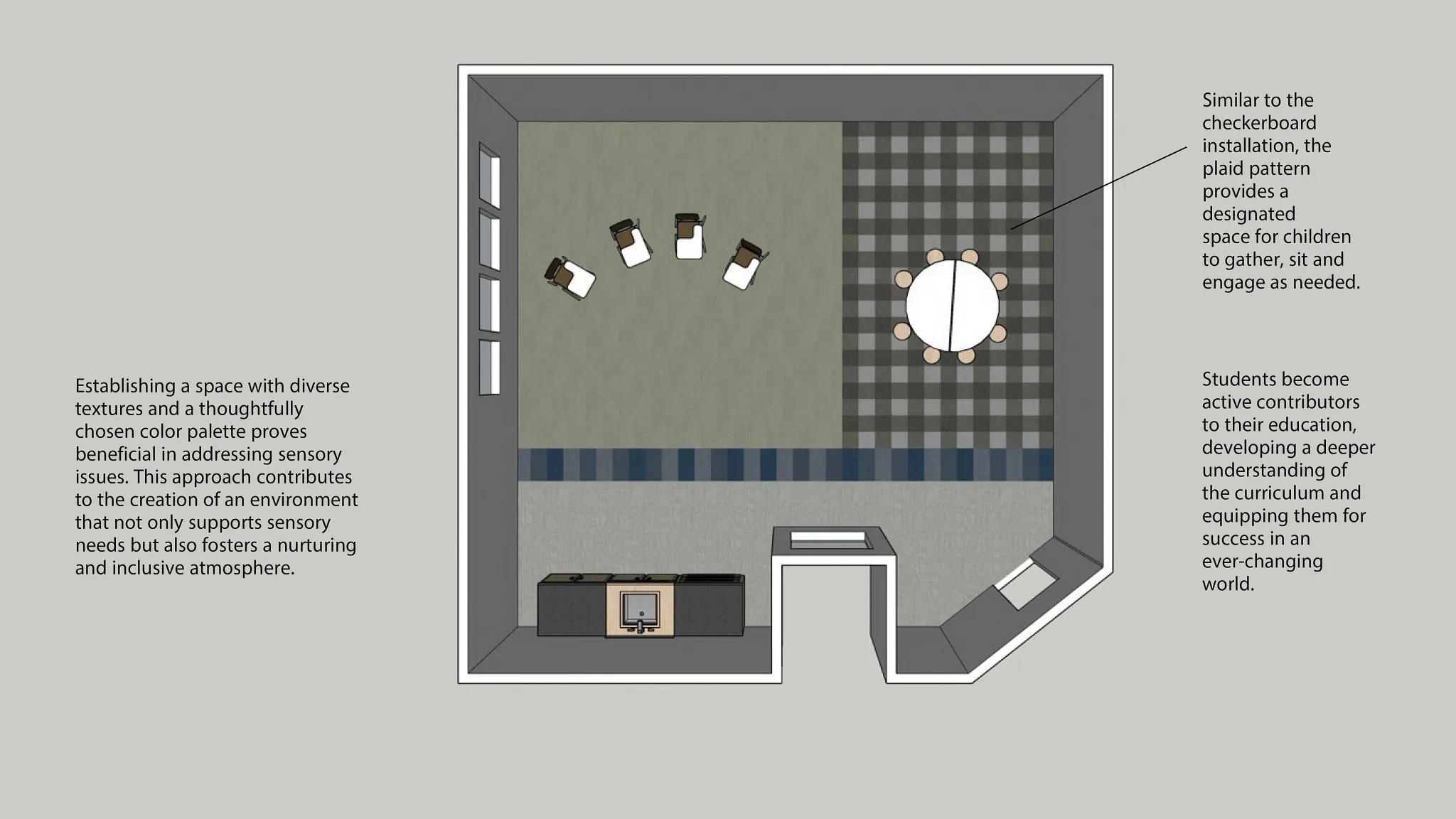K12 Education
Flooring as an Active Participant in Sensory Processing
Article Written by Sara Hudson, Shaw Contract, Education + Government Director | Published by Learning by Design
Flooring as an Active Participant in Sensory Processing
Take a moment to imagine a classroom. Do you hear the students chattering as they enter, smell the disinfectant recently used on the desks, squint your eyes to the overhead fluorescent lighting and feel the coolness of the room?
Each day a student enters a school, they encounter a wide range of sensory inputs that contribute to or hinder their learning environment and success. If students engage with their environment using more than just their eyes and ears, then teaching methods and the physical classroom environment can become equally dynamic and responsive in assisting in their learning – no matter the student’s sensory processes.
Active Learning Classrooms (ALC)
According to Edgar Dale’s Cone of Experience, people retain information the most when they are not only writing but saying and doing – Active Learning is essential in developing higher-order thinking skills like evaluation, synthesis and analysis. While 19th century learning helped prepare students for the workforce of the Industrial era, the 21st century prepares students to reach their full career potential and possibilities. Active learning places students at the heart of the education experience, enhancing engagement, collaboration and critical thinking skills – qualities that are sought after in today’s work climate (Mulvahill, Here's What Happened When We Created "Active Learning Classrooms" At Our School 2022). While pedagogy and curriculum are frequently debated and adapted to meet the student needs, it is essential to also focus on the learning environment itself. One innovative approach is to repurpose and revitalize interior elements, such as flooring, as an active participant in the learning process.
Sensory Rooms
A classroom that supports active learning can also provide learners with the necessary space, autonomy and support for meaningful play experiences (Gray, The Evolutionary Importance Of Self-Directed Play). Sensory rooms have gained popularity as schools recognize the diverse needs of students who need sensory input to learn.
But what exactly are sensory rooms? They provide an environment where individuals struggling with sensory processing can engage with and manage sensory input. Sensory inputs like noise, light and smells are processed, mulled over and interpreted, ultimately leading to reactions expressed through memory storage, physical movement or behavior. For some students, their brain finds it challenging to process an array of sensory inputs leading to frustration, fear and anger at times. A sensory room can help these students process and release sensory input in a safe environment - whether it involves throwing themselves onto a crash pad, bouncing on a yoga ball, safely hitting a punching bag or meditation. Sensory rooms incorporate elements that encourage physical activity, interaction with the subject matter and sensory stimulation, all aimed at enhancing cognitive processing and deepening understanding (What Is Sensory Play? The Benefits For Your Child and Sensory Play Ideas 2024).

Mead School District incorporated LVT, Terrain II 20mil 5mm (4110V) in colors Graphite (580), Ink (450), Aqua (370) and Azure (400), and carpet tile, Color Frame Tile (5T081) in colors Hyper Green (326), Imagine (375), Day Dream (415), Hyper Blue (436) and Charming (429)
Imagine using floors as a canvas for educators to create dynamic learning environments that promote active participation, personalized learning and the development of essential 21st-century skills. This is precisely what the Mead School District accomplished in Spokane, Washington.
Mead School District’s Sensory Floor
In a collaborative effort, Shaw Contract’s complimentary interior design service, StudioOne, partnered with Mead School District to explore options for a sensory floor within their sensory room. Their objective was to craft an optimal setting for active participation and effective learning.

Mead School District incorporated LVT, Rethink Tile (0733V) in color Core (515) and carpet tiles, Color Frame Tile (5T081) in colors Crystal (535), Disappear (557) and Coax (549)
While the elements, activities, finishes and flooring significantly impact a sensory space, it is the facilitator who truly brings the environment to life. The special education teacher, Mrs. Riener, who leads this classroom shares her experience: “The ability to add movement on the way to group [time] has increased attention to task.” She continues, “We have played leapfrog and other games on the checkerboard, and I have been able to make and change the games more easily with less prep for me.”
Mead School District also learned that carpet can be used to self-soothe students during a pre-escalation moment by simply laying or rubbing on the carpet.
Ultimately, flooring can play a transformative role in creating classrooms that break down barriers and create more space for learning – regardless of a student’s sensory processing needs or limitations. As we consider various teaching styles, subject areas and technology integration, carpet tile emerges as an ideal flooring choice. They allow for creative installations, ease of replacement and improved thermal warmth, making them well-suited for evolving educational practices like that of active learning and sensory spaces.
By designing classrooms that engage all the senses, you have the power to transform learning and inspire every student's success.
Explore this article and more insights in Learning by Design’s online magazine.
July 22, 2025